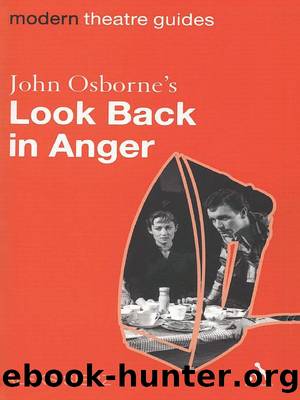John Osborne's Look Back in Anger by Sierz Aleks;

Author:Sierz, Aleks;
Language: eng
Format: epub
Publisher: Bloomsbury Publishing Plc
Published: 2011-03-14T16:00:00+00:00
3 Production History
This chapter is a brief history of British theatre productions of Look Back in Anger. It looks at the original Royal Court production in 1956, and at several important revivals, as well as at the two film versions of the play.
The original production
Most theatre histories tell the story not of a play, but of a playâs opening night. Usually, the whole run of a play is represented by just one performance - the one the critics wrote about. In the case of the first production of Look Back in Anger, which opened at the Royal Court on Tuesday 8 May 1956, the opening night was the first night of this new play, although there had been a public dress rehearsal on 7 May. At the time, the Royal Court did not preview new plays. Coincidentally, 8 May was also the birthday of Osborneâs deceased father.
The fact that this was the playâs first public performance accounts in part for the Shockwaves it instantly generated. To have some idea of the clash of values, you have to imagine half the audience attired - like the English Stage Companyâs council - in evening dress. There were flowers in the foyer. The performance would have finished with the national anthem being played. To an older generation of theatregoers, the first shock was visual. Reviewers described the set, designed by Alan Tagg, as âshabbyâ, âsordidâ orsqualidâ.The household squalor is a little overdone,â opined the Financial Times (Taylor, 1968: 35-56). Production photographs show that, despite the fact that this play was later seen as the harbinger of Kitchen-Sink Drama, there is no kitchen sink. But, since the room is an attic, there is a cistern at the front of the stage. If the playâs laddishness is emphasized by a box which bears the legend âBEER IS BESTâ, its politics of disillusionment is neatly conveyed by a newspaper poster about rising prices which is pinned to the wall: UP AGAIN: BREAD PHONES SMOKES. In this production, music was also important: âEach curtain went up with dead-beat traditional jazz with plenty of trumpetâ and âat the end of the first scene in Act Two, Bunk Johnsonâs âJust a closer walk with theeâ was brought in, harsh and loudâ (Osborne, 1957: n. pag.). Other mood music included Vaughan Williamsâs Symphony in E. Actors Kenneth Haigh (Jimmy), Mary Ure (Alison) and Alan Bates (Cliff) performed the play, which - on the Lord Chamberlainâs insistence - had nine changes, including âthe cutting of a âlavatoryâ and a âhomosexualâ reference and the alteration of a phrase that contained the words âexcessive love-makingââ (De Jongh, 2000: 182). Haighâs style emphasized Jimmyâs declamatory rudeness, his rhetorical hectoring and his deliberate antagonism, while Ure went on ironingwith a look of blanched sorrow on her face, which is white and exhausted after a hundred sleepless nights, tormented by a hundred ceaseless headachesâ (Hobson, 1984: 190). The acting was probably quite raw, and some witnesses remembered unforgettable âmoments of naked emotionâ, such as âHaighâs breathless,
Download
This site does not store any files on its server. We only index and link to content provided by other sites. Please contact the content providers to delete copyright contents if any and email us, we'll remove relevant links or contents immediately.
Cecilia; Or, Memoirs of an Heiress — Volume 3 by Fanny Burney(31455)
Cecilia; Or, Memoirs of an Heiress — Volume 2 by Fanny Burney(31406)
Dialogue by Robert McKee(4160)
The 101 Dalmatians by Dodie Smith(3298)
Bound by Hatred (The Singham Bloodlines Book 2) by MV Kasi(2951)
Harry Potter and the Cursed Child - Parts One and Two by John Tiffany(2921)
The Art of Dramatic Writing: Its Basis in the Creative Interpretation of Human Motives by Egri Lajos(2857)
The Beautiful Boys: A High School NA Reverse Harem Paranormal Bully Romance (Shadowlight Academy Book 1) by Gow Kailin(2727)
Angels in America by Tony Kushner(2390)
Carrie's War by Nina Bawden(2354)
A Clockwork Orange by Anthony Burgess(2319)
Unlaced by Jaci Burton & Jasmine Haynes & Joey W. Hill & Denise Rossetti(2251)
The Femme Playlist & I Cannot Lie to the Stars That Made Me by Catherine Hernandez(2170)
Drama by John Lithgow(2116)
Open Book by Jessica Simpson(2112)
Outside Woman (BWWM Amish Romance) by Stacy-Deanne(1968)
Terrorist Cop by Mordecai Dzikansky & ROBERT SLATER(1962)
Yerma by Federico García Lorca(1921)
Leo's Desire by Sundari Venkatraman(1813)
